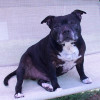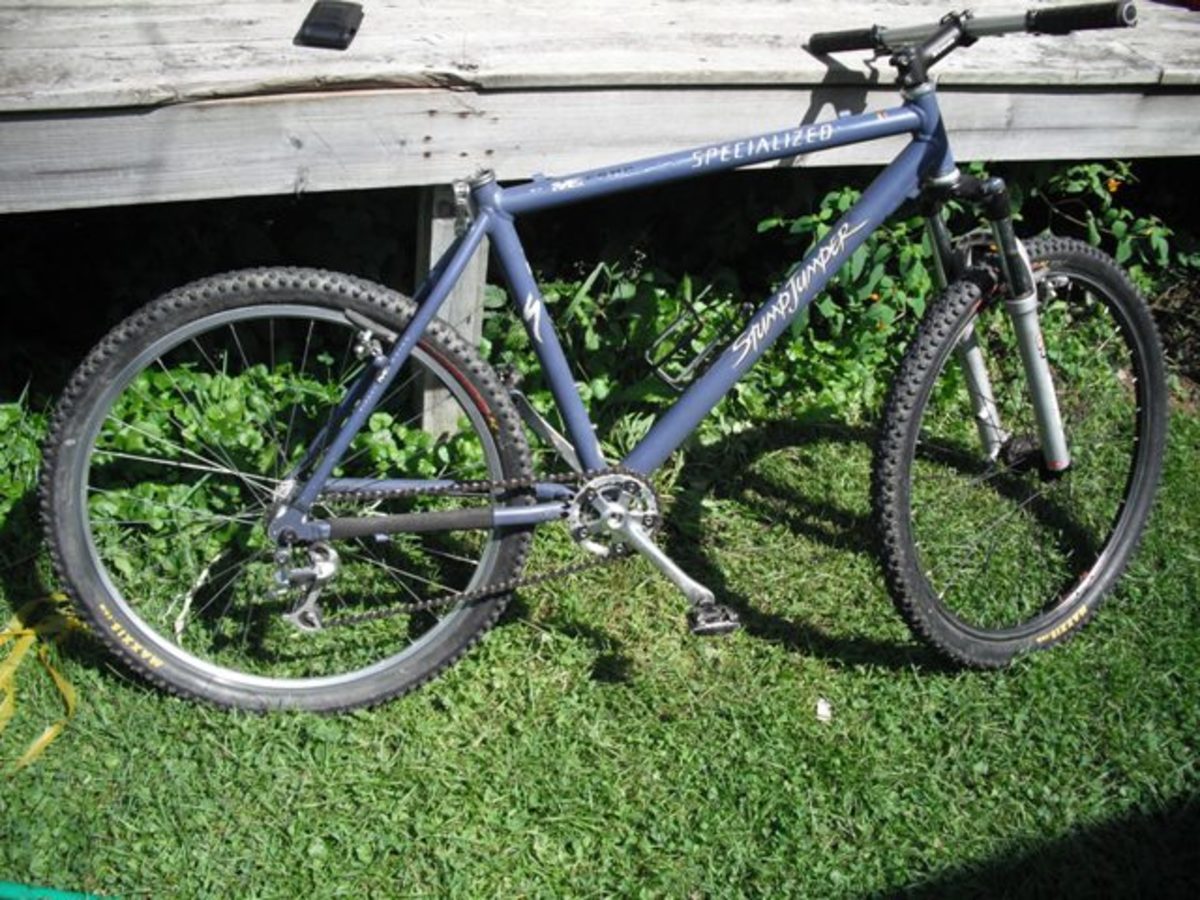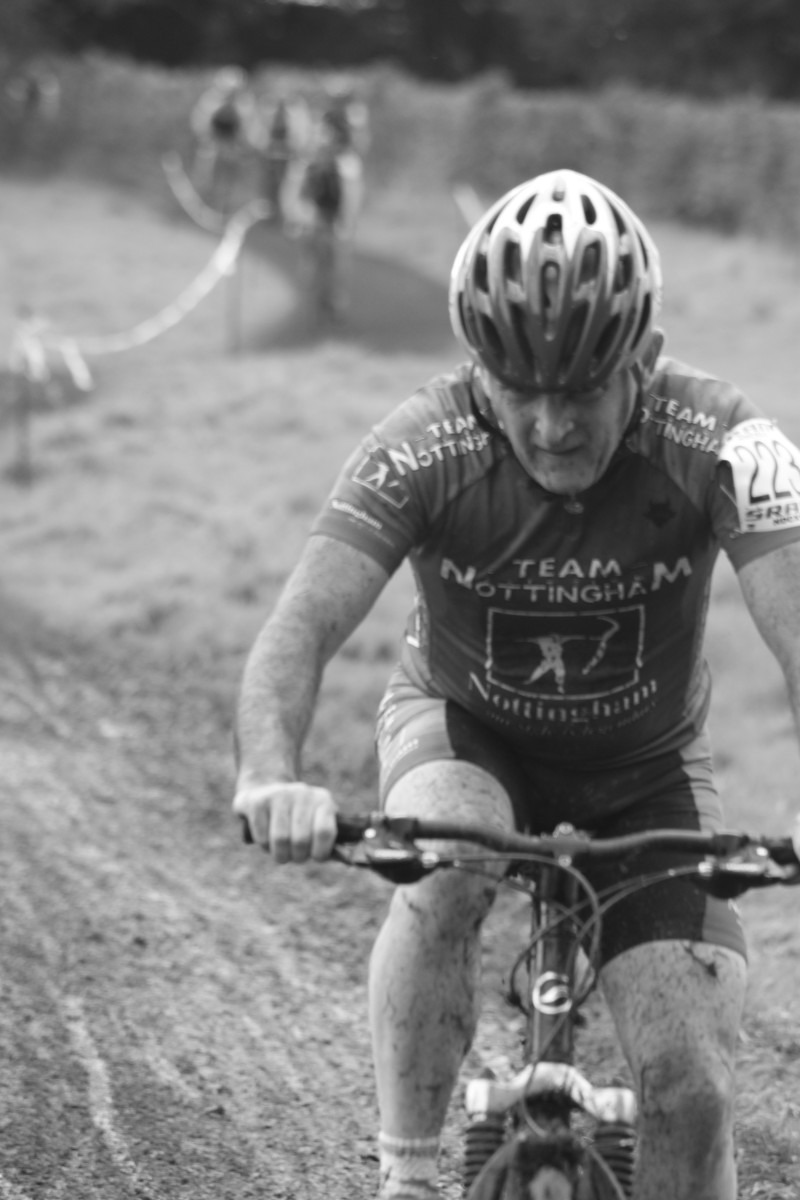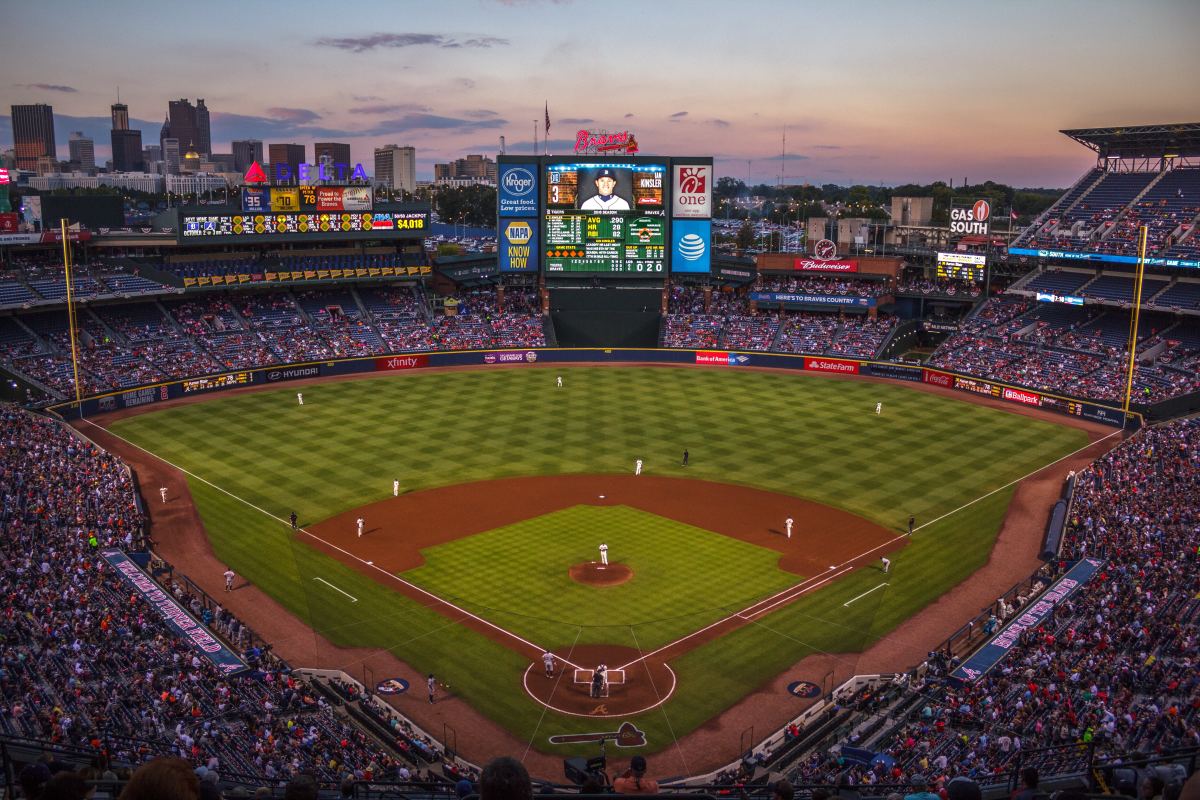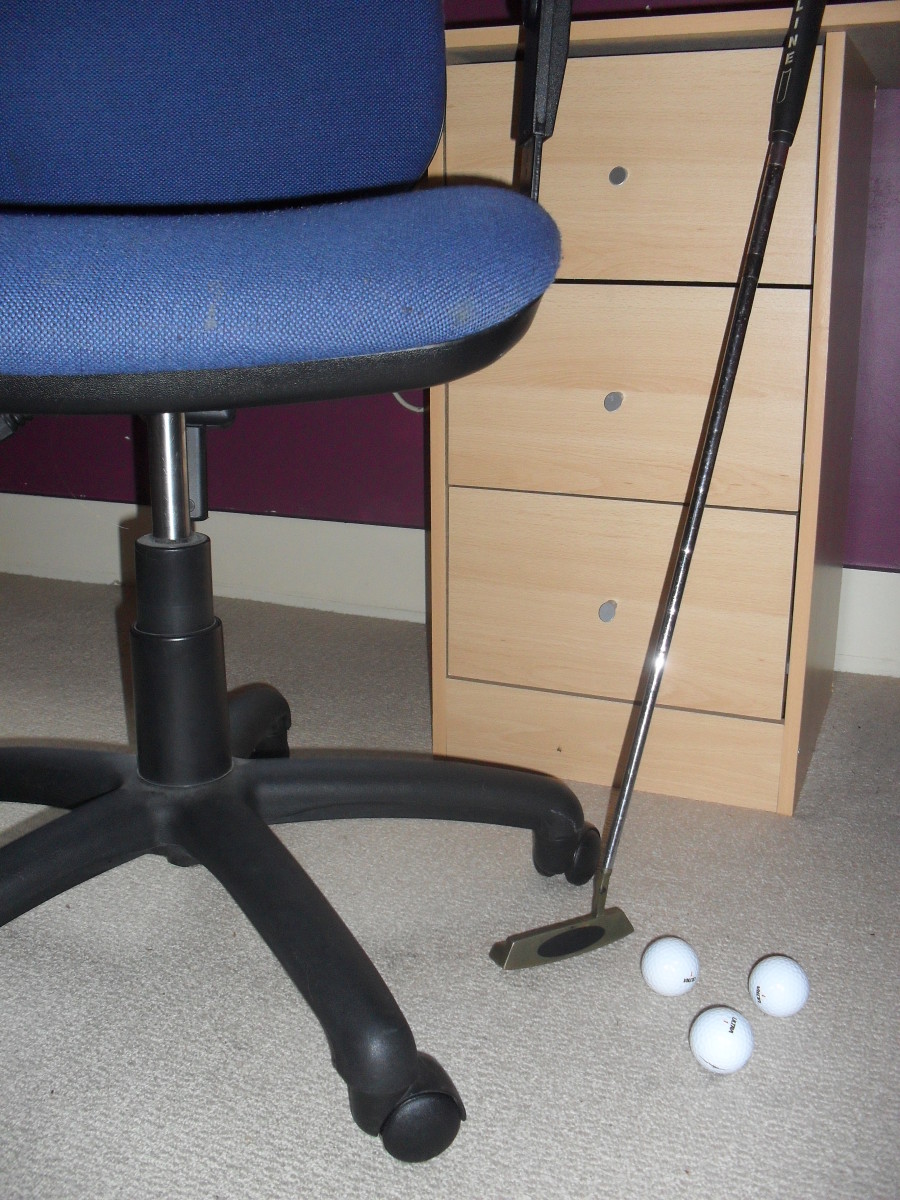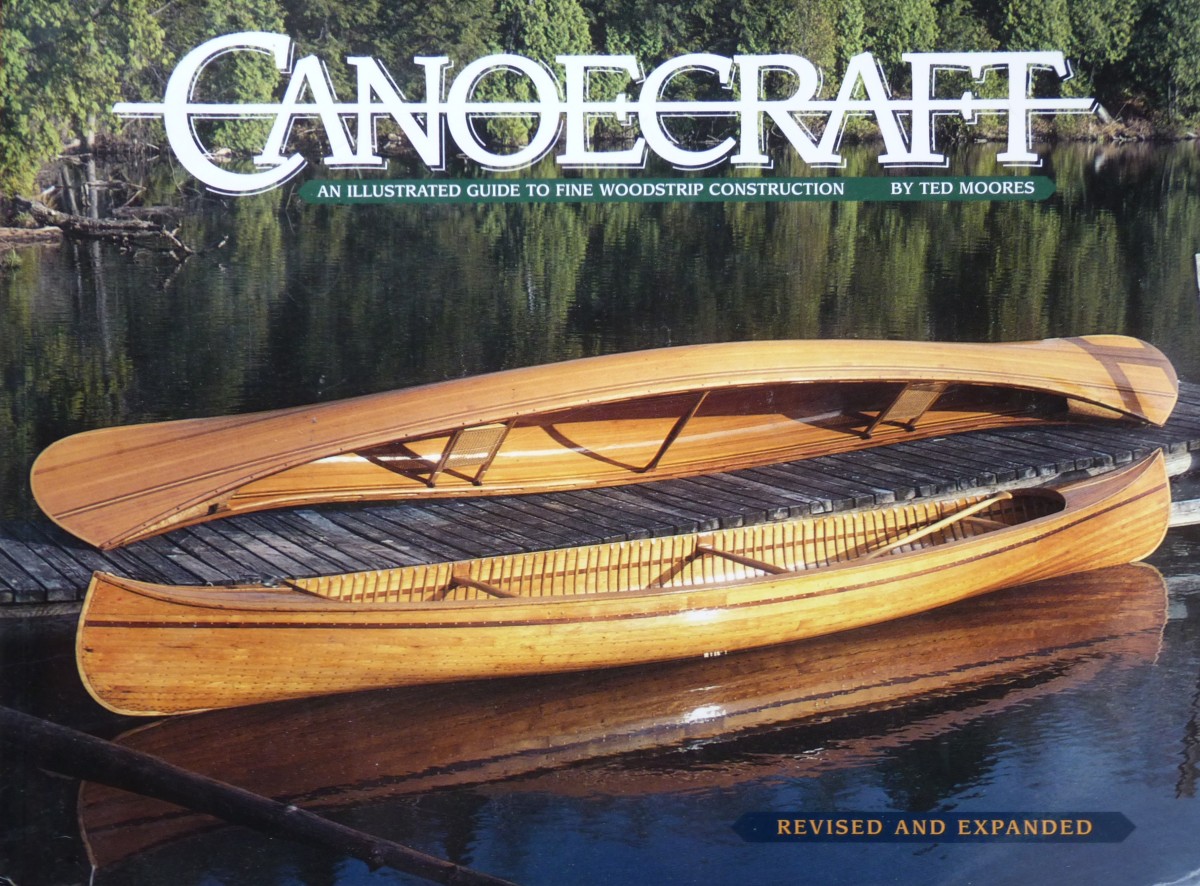Mountain Bike Riding for the novice. What do I need to know ?
Getting started with mountain bike riding?
I have been riding my mountain bike now for nearly 12 months and at the start I found it hard to get good information on what I should and shouldn't do, what type of bike to buy, what gear to get and where to start riding.
I am 57yrs old and finding someone who would talk my language, you know tell me stuff about bikes and what I would need and how to go about it was hard. To them, it seemed like just sell the old bloke whatever.
I did some research of my own, I came up with the outcome I wanted, what I needed to do to achieve that outcome and how I would go about it.
So this is how I got started.
First of all you need to work out why you want to ride a mountain bike, is it for pleasure, the social event with friends, exercise, health reasons and then how often you would ride.
My reason was I needed to lose weight and the only way I could see myself doing it was by riding a bike, It is the one thing that I do enjoy and have ever since I was a kid, I hate running and diets will never happen.
Why a mountain bike when I already have a very good road bike in the shed. I have had it since 1996 however I got bored and lost the drive to ride it, I needed something new. I watched a mountain bike endurance race as they passed through town and saw people my age riding. I could do that, I just need to get myself fit enough to enter next years event in 2013. So I did and this is how I went about it.
I knew that I needed to do this every day for me to be able to loose the weight and become fit enough to enter the race without becoming a burden on the health system, and get to the finish line by myself, by the way it was a 50 kilometre endurance up and down some big hills.
I have a reason for doing it and how often I needed to do it, the next step was what type of bike, by the way bikes ain't bikes and this my friends is limited to how much money you are prepared to spend to do your stuff. Some more expensive bikes have price tags of $7000 and upwards. However very cheap bikes are just that and will fall apart quickly and you end up spending more money on them over the life of the bike or you junk them and buy the expensive one in the end.
Mountain bikes come in cross country and downhill, down hill is for those of you who like to go as fast as the bike will go down hill with jumps and all that stuff, I am too old for that and I know what pain is all about. So a cross country bike was for me.
I knew the bike had to be able to stand up to being ridden every day in that off road environment, and this is another area where you have to decide on what type of surface you are going to predominantly ride on.
If you are going to ride on sealed cycle paths, your bike could be of a cross trainer type, that is a more road going than off road, but has the more upright riding position with bigger tyres and some form of suspension. If you are only ever going to ride on unsealed roads or fire trails, you could do this with a medium cost entry level mountain bike. Again this bike could have some form of front and rear suspension.
The latest trend here at the moment is to have a hard tail bike, that is one with front suspension and none at the rear. With a hard tail bike all your effort goes into turning the rear wheel and not into making the rear suspension move which takes away the power to the rear wheel. I think if I was a boy racer again I can see the advantage of this type of setup.
Hard tail
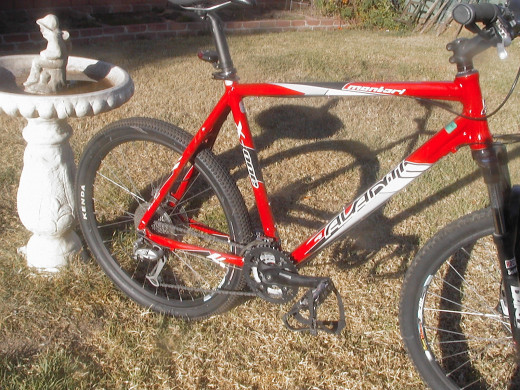
However I do like the comfort aspect of front and rear suspension for us older riders, it is comfort that will allow you to keep on riding for longer and the control you have over the bike I think is better. Why, because you are not being jolted up and down when riding over ruts, rocks and all that bumpy stuff.
The rear suspension takes out the shock to your body and makes it fun to ride again, if it is not fun then you will give it up as a bad joke and put the bike in the shed only to see it come out once a year for a dust off, and then you have wasted your time and money.
My decision was made, I needed a bike that would make me want to ride it, It had to have front and rear suspension, it needed to be comfortable to ride and to keep me wanting to ride on the days I didn't want to.
front and rear suspension
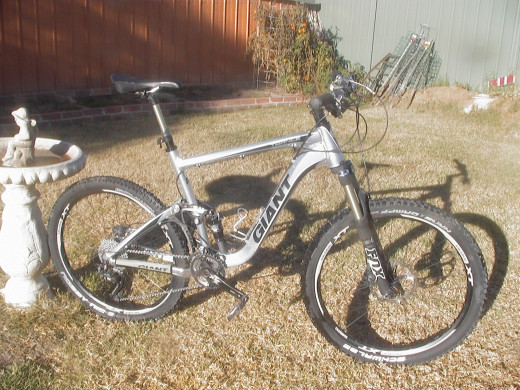
The price I paid played a part in it as well, I had to justify the expense to myself and ride it as much as I could to get my monies worth. As a general rule the more the bike is worth the better the running gear it comes with, the longer it should last before you have to carry out maintenance for worn out parts.
So with this in mind I went to all the bike shops around town and looked on the internet at second hand ones as well.
I had a price that I could afford in my mind, I looked at most of the options and spoke to a number of people about them. I decided on a brand, next was what size bike did I need. Was it going to be a 26 or a 29 inch wheel size.
Bikes come in small, medium, large and extra large frame sizes. I brought a large because I was large and I needed to sit within the frame and not on top of it like a mountain on a mole hill. A larger bike for me was not due to being tall, but fat and as we get older it is easier to control something that we sit in rather than trying to balance on top of it. But try it yourself, I found it was better to go up a size or two.
As for the wheels size 26 or 29, I brought a 26 and in looking back and knowing what I know now my next bike will be a 29ner. Why think about it like this, a 26in wheel is smaller in diameter than a 29in, so which wheel would travel over ruts and rocks easier, the bigger wheel will because the smaller one will fall into the hole and not go across the top of it like the larger one.
If you want a good demonstration of this, take both bikes out to the kerb and roll both towards it, you will find that the 29ner rolls up and over the kerb a little easier than the 26er. So as you are now the item that is suppling the power, which one would you spend less energy on to get the work done, the large wheel is easier. However in saying that a smaller wheeled bike is more nimble and able to be moved around a lot better. But for my style of riding both are just fine, I would like to have both sizes in the shed so I could pick the best bike on the day for the area I was going to ride.
I found the one I wanted and parted with some cash, by the way some bikes do not come with pedals so you have to buy them as well, I went with flat type pedals and not the clip in shoe type. As a learner to this new riding style the last thing I need was not to be able to put my foot down when needed because it was locked to the pedal.
You are better off with flats/platforms as they call them when learning because you will have to put a foot down sooner or later to stop from falling over. I can tell you it comes sooner, much sooner than you might think. However flats/platforms do have little spikes in them which help your runners grip the pedal, these can cause some nasty cuts to your shins and calf muscle area if you are not careful.
The best type of runners to buy for your bike are ones with a smooth sole as they will be able to get better grip on the pedals. I use a really old pair that have the sole nearly worn out, they work better than a new pair with heaps of tread. I am still using flats.
pedals
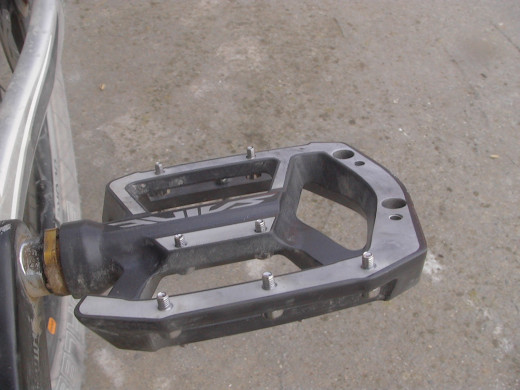
Off home with my new toy, proud as could be, couldn't wait to go for a ride.
Next day out came the new toy and off I went around the block for a test ride, then off to the local dirt walking track which had a few little rises in it to give it a work out.
What a let down, I could not be more disappointed with the bike. I spent more time bouncing up and down when I pedalled an going forward, I thought I had made a huge mistake, so off home with tail between my legs, shaking my head, what was wrong? I should have some idea about bikes, I know about motor bikes and bike dynamics.
What was wrong? the bike had not been set up for my weight, the rear shock absorber needed more air pressure in it and the front suspension had to be tuned in as well, even the seat height was all wrong. There are sites on youtube who show you how this is done, watch and learn and then make the adjustments. As a motorcycle rider I know that you only make one adjustment at a time, then give it a try to when you are happy move on to the other end. Start at the rear and move to the front as the rear can be the quickest to setup.
I set the bike up for the walking track as this was where I was going to be doing most of my riding until my fitness improved.
Back to the track and around I went once, those little raises now where mountains, I could only do one lap which was a total of 3.2K's not far, but when you are unfit it is. So I started with riding one day and the next off, so every second day for a week, then I rode 2 laps every day. The next big step was 6 laps everyday for a week. Then on to 8 laps and then 10 laps per day Monday to Friday.
After about 6 weeks my fitness had improved and it was time to tackle one of our local mountain bike parks. I live in Canberra (Australia), we are lucky and have some of the best mountain bike parks around and all with in about 40 minute drive from home. They are well maintained and you can ride for 5k's or 50k's if you like, these are Mount Stromlo, Sparrow Hill and Bruce Ridge.
First was Mount Stromlo with single track riding, again what a shock, it seemed so hard and I was using all my skill just to keep on the bike and keep up with Lyall who was showing me the way. We rode only 5 k's and I was shot, dead in the water, no more left. I had been training on a dirt walking track, it didn't have rocks and ruts and all that stuff in it, it was reasonably smooth. Not this, now this is what mountain bike riding is all about, go where no man had gone before , well a few actually quite a few before me.
The next weekend we went back and I was using so much of my brain to keep riding and not to fall off I had no idea where I was going, this was so draining on the brain power over the next few months. As I became more comfortable with the riding in this environment I started to remember where I was going. I hate rocks and they seemed to be every where we rode. When dealing with rocks and ruts and steep down hill stuff, momentum is your best friend and helper, it keeps you up right. Go to slow and you will fall off, speed/momentum will carry you over that rock/rut.
I retuned my suspension again for this new track as it was completely different from the walking track.
Next weekend, off to Sparrow Hill and a 20k ride, did it in 1.50hrs again I was tested by the climbs and had to walk up a number, a few steep down hill sections tested my balance, one up and over a log I couldn't do and a rock section about 10 metres long I had to walk over.
As I am unable to stand up and pedal when climbing, as I am not that coordinated at the moment I find it very hard. I stay seated, using all my energy to turn the pedals I use the gears to my advantage even though I may go slow, I plan my path the best I can. I always look for the smoothest, straightest path to the top. I will lean forward as much as I can to try and keep my weight in front of the rear wheel and as low as possible.
If you are able to stand up and pedal you are able to move your weight further forward and reduce the risk of the front wheel lifting off the ground. Lifting the front wheel is using the power that was going to turn the rear wheel and using it to lift the front wheel off the ground which can cause you to lose your forward momentum and come to a stop. It is also easier to balance the bike while standing up, so if you can stand up its the best way to go.
When changing gears It is better to make the change when you are able to relax a little, it helps for a smooth transition from one gear to the next. So I try and plan to use the same gear at the bottom of the hill all the way to the top and then change up or down for the next section. There are some sections where I have to walk because I am unable to stand up and pedal.
Pedalling the bike was another area that I found hard at first, pedalling so fast and going nowhere. I had to improve the speed in which I was able to turn the pedals, this is called cadence. You need to increase your momentum just prior to an obstacle so that means you need to pedal faster for a few meters before it to gain that little bit extra to get you up and over it. So when I rode my walking track I would only use the lower gears and build up my cadence, which also helped me with my balance at slow speed.
Sparrow Hill, I liked it because it flowed with gentle slopes with a climb here and there and only 2 rocky sections and that steep down hill section was only my imagination. I rode Sparrow Hill every weekend and was now able to look around at where I was going and I could remember what was coming up next. I felt good the fitness was on the up, the bike handled like a dream and I was able to conquer those 2 obstacles that had been giving me a hard time in the early days.
But I knew that I had to go back and ride Mount Stromlo, it had tracks everywhere, from beginners to professional. It was the best in our area and everybody did Stromlo. I decided on the weekend I would give it a go, up the main track I went to the top, I didn't walk once, I was slow but never stopped until the top.
I made it in 58 minutes and a young guy asked how I was going as he had just taken 27 minutes to get there, I said ok rolled off down the other side and back down to the car park. So now I had a good idea of my fitness level and it was time to work on that. The next thing that needed to improve was my skill level, my practical riding of the bike in all areas, from the flat sandy tracks, rocky areas to the fast down hill sections and those step downs.
Watched other riders and how they did things, how they went over obstacles and down hill, how they went down a sharp drop off. These are all the same techniques used when you ride a dirt bike (motorbike) I know I can do this the only difference is, I am now the engine and did I have enough power in me to do what I knew needed to be done, that was the million dollar question.
I continued to adjust my suspension and fine tune it, as now I was riding with more confidence and with my fitness improving allowed me to go faster.To get the best riding out of your bike and to feel good about it and not to be worrying about coming off at every obstacle you need to tune your suspension for your riding style. Once you have done this, your riding will be fun and you will have the confidence to tackle what ever comes your way and just maybe pass a few of those younger riders along the way.
If you are unable to adjust your suspension yourself go back to the bike shop and ask them to show you how or ask someone out at the track to give you a hand, most people are happy to help other riders.
When adjusting your suspension you need to ride on the same track every time, so you can make an informed decision whether that adjustment was better or worse. I see people make a lot of adjustments and then ride at different places and they are still chasing setup months later, because they didn't ride the same track it is impossible to see an improvement for that given adjustment, if you continue to ride over a completely different obstacle how could you tell if it was better or worse.
The front suspension will take a little longer, but take your time and you will get there. Your suspension needs to work when riding over ruts, rocks and tree roots while going around corners. This is the time when it has to do the most work. There are a few areas I ride most days that have fast down hill sections with rocky/rutted right and left turns, I have got this one sorted out slowly and now I can go as fast as I dare. The front of the bike doesn't change direction by it's self, it still goes where I am aiming it with little effort on my part.
Another area is a right left around a tree with ruts and roots everywhere, I am amazed how well I have been able to get around here so quick, it just goes around with no effort at all. The front suspension is working correctly allowing the wheel to move up and down in a controlled manner. I am not having to deal with a change in the steering direction because of the bouncing ball effect from one rock to the next and side to side.
On those fast down hill sections with a lot of ruts and rocks the rear suspension needs to be soft to stop the rear of your bike bouncing all over the place and making it hard to control. A softer rear end really does make a difference to the way your bike handles and so good to ride down those fast sections. For those uphill and flat sections I leave the rear shock on the harder setting so I can get the power to the rear wheel and not to waste it on suspension movement.
My shock has three valve positions and can be adjusted just by turning a small lever.
Tyre pressure is also critical, the rear for me and my weight is about 38psi and the front is about 22psi. If the tyre pressure is to high you loose traction and start to skid in corners and you can spin the rear wheel when climbing steep grades, which looses momentum and you can come to a stop. We need traction to be able to keep moving forward. On the other hand if the tyre pressure is to low you will keep getting flat tyres because the rim will hit every rock you run over and this will cause a pinch flat. This happens when the rim jams the tube between the rock and rim causing the tube to be cut. A flat front tyre can be a hand full at speed, a flat rear tyre is able to be control easier.
Now the bike is set up, next the training sessions for that 50k endurance race and to improve my skills and practical riding.
When rolling down hill stand up on the pedals with your weight as far back behind the seat as you can get it and take any weight off your arm, flow with the bike and lean into corners and roll around them, do not steer the bike unless you need to negotiate an obstacle. Use your brakes before the corners it is more efficient and you can brake harder in a straight line. If you still need to brake around the corner you will not be using as much force because you were able to get most of the work done prior to it.
Do one thing at a time, the brakes first and then negotiate the corner. If you are going fast and try to brake in the corner, most people will panic and tense up, this will cause you to run wide off the corner. You need to look where you want to go, not off to the side because that's where you will end up.
Look as far ahead as you can, in doing this you will have time to plan your path of travel and to see what obstacles are coming up, not finding out about them at the last second just before you hit it.
look ahead
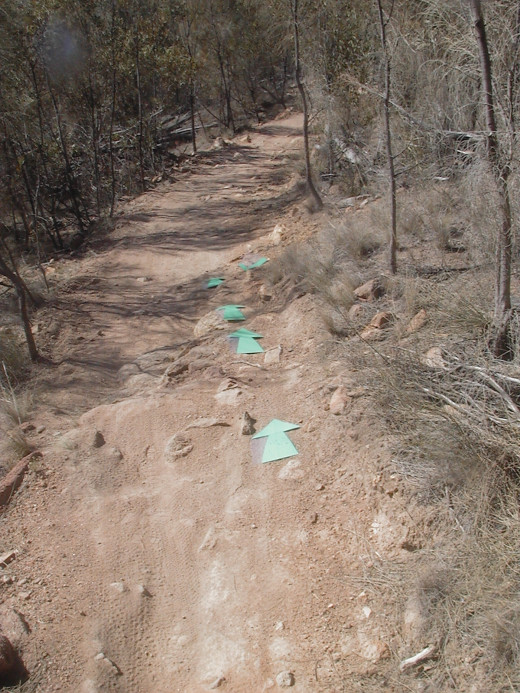
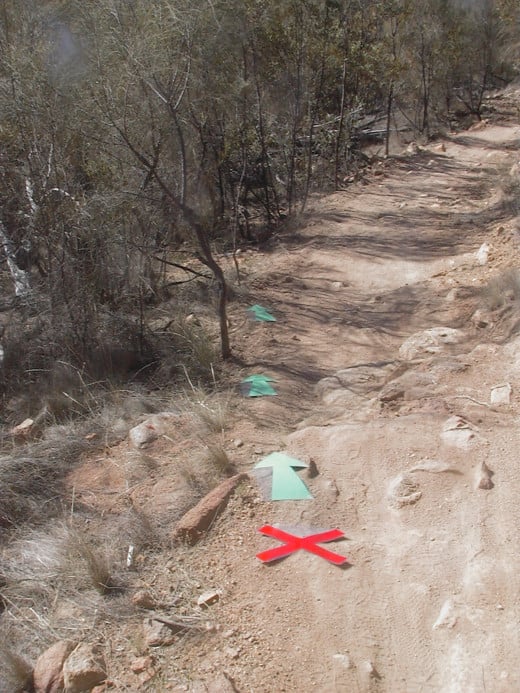
If you do lock the brakes up and the front wheel skids you cannot steer the bike and you will fall off. If you want to try this, ride along slowly and apply the front brake gradually and keep pedalling until the brake locks, you will need to use a lot of balance to keep the bike upright. It was far easier to ride along even at a very slow speed with all the wheels rolling, than to have the one at the front stopped.
If you are going to lock up any wheels, it is better to lock up the rear wheel because you are able to control that skid a little easier. Remember as a kid doing this for 10 or 15 metres and how you were able to slide the bike from side to side without falling off. But the rear brake takes a longer time to stop you.
The front brake is able to stop the bike quicker than the rear because of the dynamic transfer of weight to the front, the extra weight on the front wheel gives it more traction, which reduces the skidding effect. Try this simple test, while walking beside your bike pull on the rear brake, the rear wheel will lock and skid but the bike will not stop instantly, however now do this with the front brake the bike comes to a complete stop with no front wheel skid. It will do the same thing when you are riding it.
The brakes operate through a lever action on your handle bars, the more you squeeze the more stopping power you get at the wheel, however you must not grab at the brakes suddenly, this can cause wheel lockup. Only use 2 fingers on the levers at any time when braking, as this does not allow you to apply more force to the lever than required and keep the others wrapped around the hand grip for stability. If you look at the brake lever they are designed for 2 finger contact.
2 finger braking
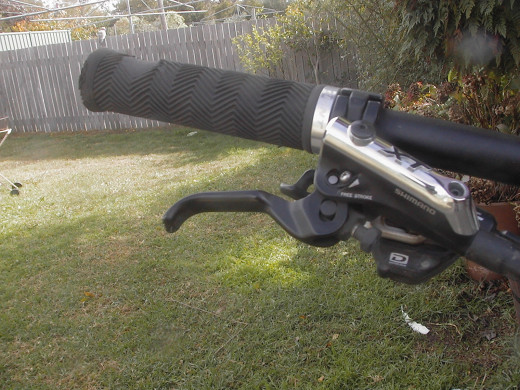
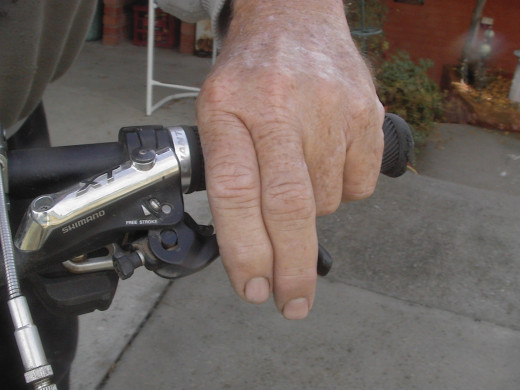
To be able to negotiate a quick downhill run you need to have very good front brake feel so when the front wheel bounces over obstacles you do not lock it up as it lands back on the track, the same with a steep rocky downhill section, allow the front wheel to roll over rocks by releasing the front brake just prior to the wheel coming into contact with the rock. If you don't you are likely to lose all your momentum because you are using the brakes and the rock is acting as a brake on the front wheel, causing the bike to stop and for you to go over the handle bars.
If going up and over anything the bike needs to be able to rotate underneath you around the pedal crank, don't hold on too tight it needs to move to be able to keep you upright. You should be standing up or leaning forward and as the front wheel raises up the obstacle let the handle bar come towards your body and as you move over it bring your weight back behind the seat and you should be ok. If you don't let the bike move underneath you and you stay in the same riding position you are likely to pull back on the handle bars and you could flip over backwards.
When riding around sandy corners keep out of the real loose sand on the outside of the corner as the bike could slide out from under you, the best place to ride is in the area where the loose sand is brushed away from the hard surface on the inside of the corner. You use the soft sand to act as a small burm which helps with cornering.
cornering
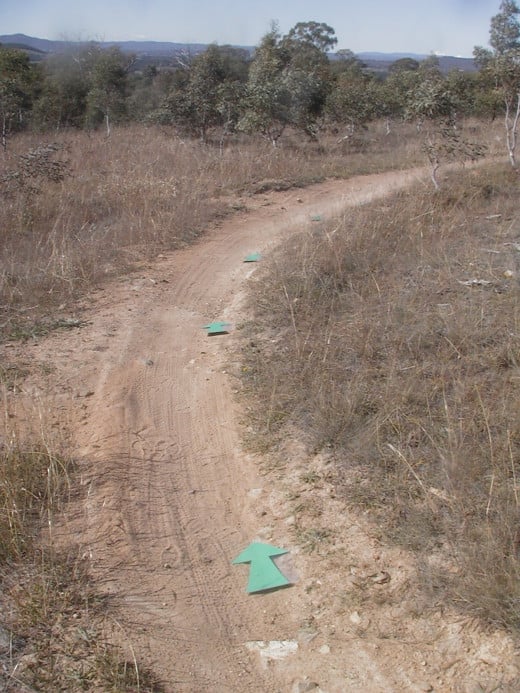
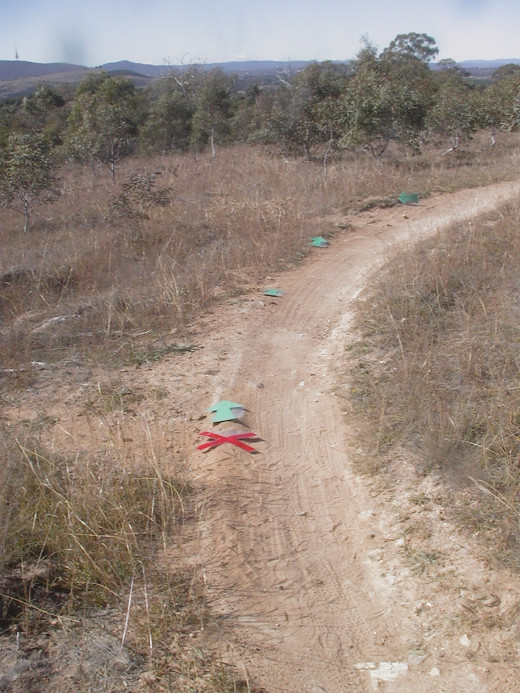
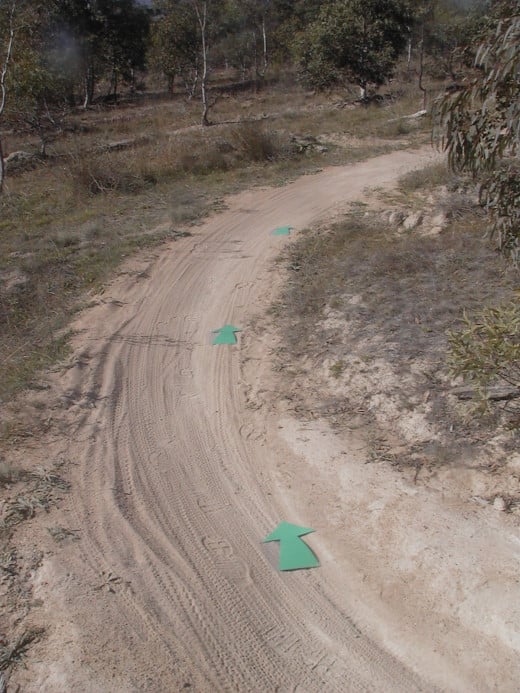
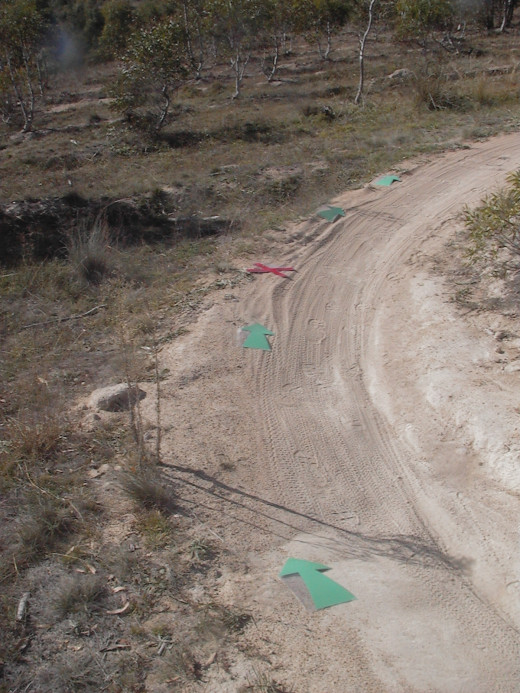
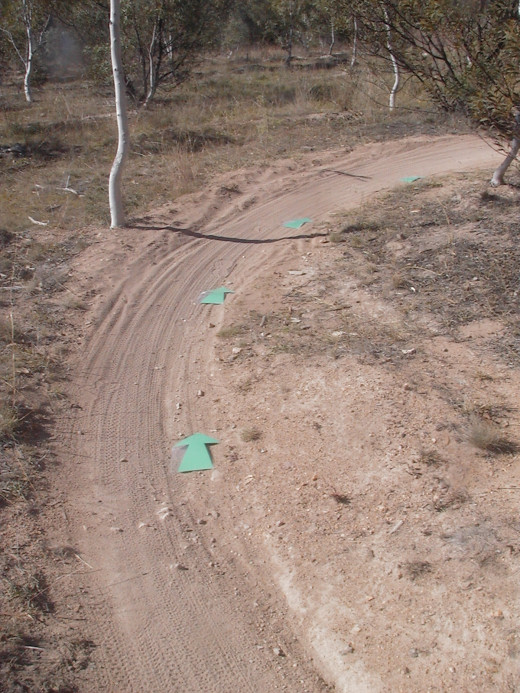
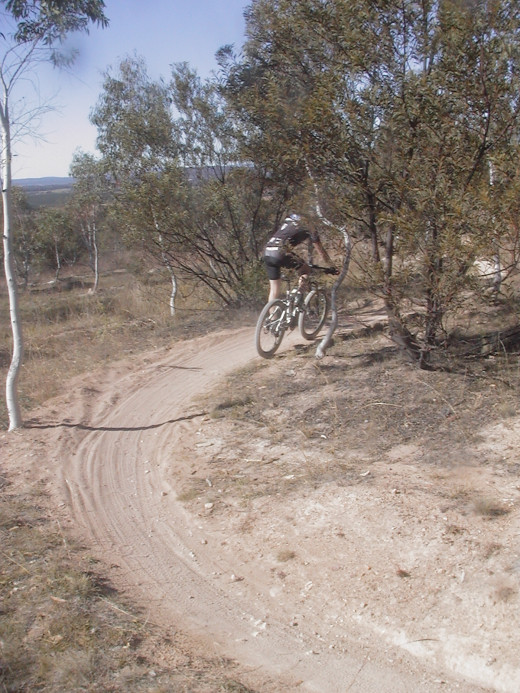
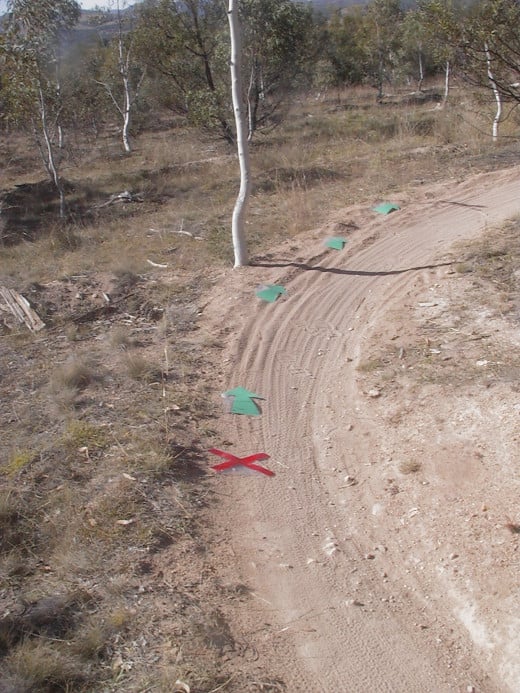
On fast downhill sections where the corners have been made into burms the faster you go the further up towards top of the burm you ride.
These types of corners are not for the faint hearted, yes you have to first have a go, but you must have good practical skill before you attempt these super fast corners, remember there could be a fast rider coming from behind and the last thing you both need is an issue near the exit where they could be travelling very fast and you super slow.
high speed cornering
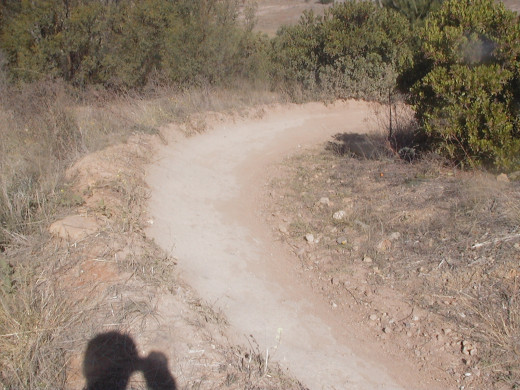
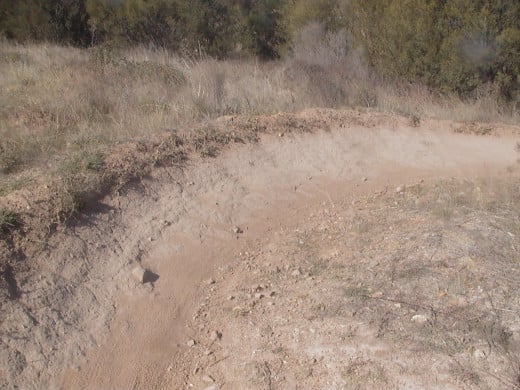
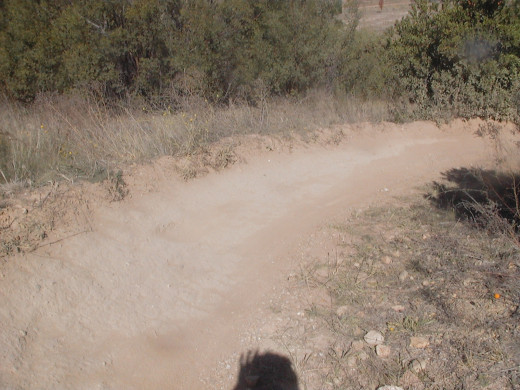
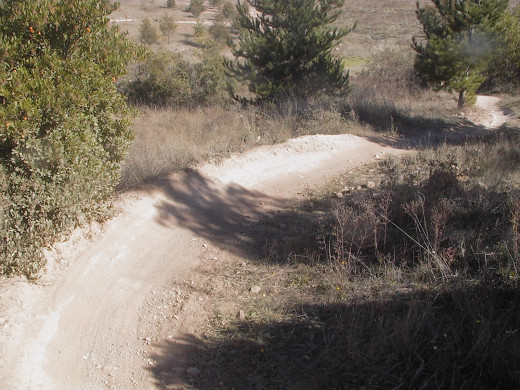
Most of all only ride as fast as you feel safe, not at the speed your friends think you can ride. You will only become a better rider if you continue to practice everything that I have spoken about. Research for yourself and watch others, learn from your mistakes. Keep a constant lookout for faster riders coming from behind and move out of their way as soon as you can, talk to them and tell them when you are going to move over, the good riders will always thank you for it and if you ride that area often they will get to know you and your riding style. Nothing frightens you more than to have another rider blast past you when you are not aware they are coming. The very good riders will be able to go past you without you moving far off the track.They will let you know that they are behind you as well.
Things that you need to have are a good bike pump with gauge to check your tyre pressure before each ride, a small hand pump to take with you along with a spare tube and tyre changing tools, don't bother with patches when riding it is easier just to replace the tube and patch the flat one when you get home. I also don't bother about that tyre repair goo you put in the tyre as it can get messy if not done right.
I have just taken to carrying a first aid kit with me, the other weekend I was riding my normal track up Mount Stromlo when I saw and heard a person approximately 100mtrs in front of me fall down the side of the hill, as I rode up towards him his partner came running down the track towards me very distressed. He had been hurt somehow. I arrived a few second and found that he had fallen onto some very sharp blue stone rocks that had been broken up to make the track.
The rock was razor sharp and one had cut right into his left calf and caused a gash about 80mm long which had opened up to about 50mm wide. He was lucky that it had only cut through the skin, fat and not into the muscle or it could have been far worse. We were only about halfway to the top. Help was 30 minutes away and then the ambulance would take another 20 minutes to find us. I knew he was not going to bleed to death and convinced him of that. I used his t-shirt and her jumper to tie around the wound and cover it the best I could, with the help of another rider, he headed back to the car park and the awaiting ambulance.
Be aware of fatigue and what the signs are, if you are starting to wander left and right on the track and find it hard to keep the bike travelling in a straight line, day dreaming about other things, making riding mistakes that you normal don't do, then these are some of the common signs of fatigue. Keep an eye on your riding friends for these sings as well, if a friend stops talking and is slowing down and wandering left and right then they are becoming fatigued.
You need to build up your endurance before you tackle those harder tracks and steeper longer climbs, spend as much time as you can riding, it doesn't matter if you just ride around your local suburb. Try to ride for about 30 minutes, then for 40 minutes and then 1 hour, even if the road is flat you will still improve your stamina.
